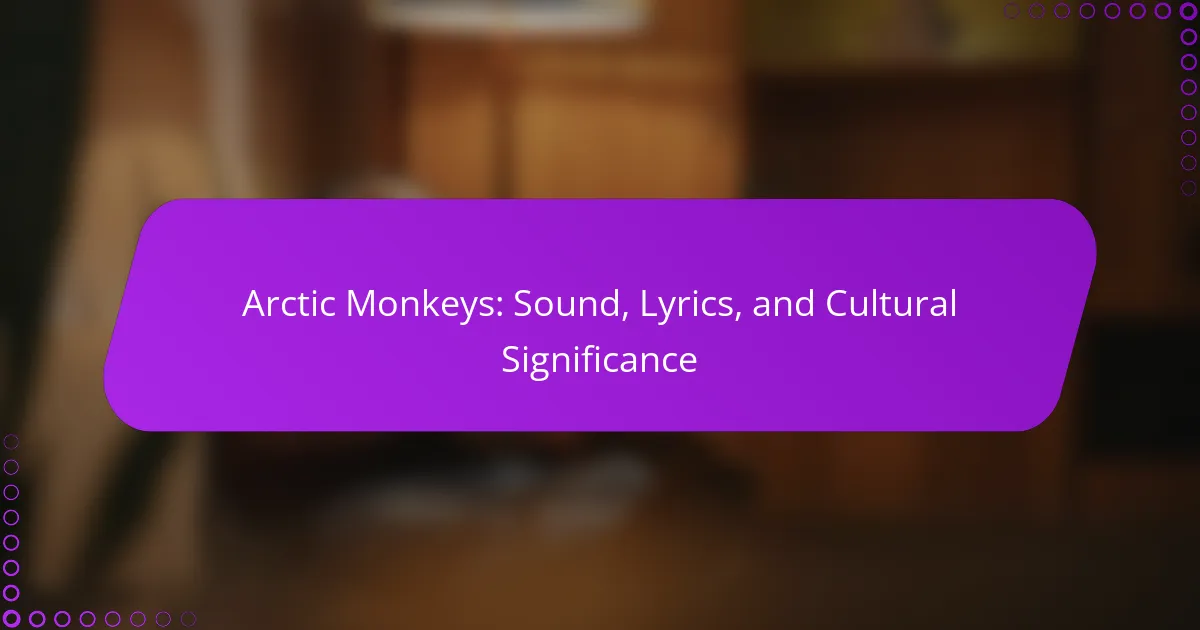Arctic Monkeys have significantly shaped contemporary music culture with their innovative sound and relatable lyrics. Their evolution from garage rock to a polished, experimental style reflects artistic growth. The band’s lyrics explore themes of love, social commentary, and nightlife experiences. Their cultural significance is evident in their influence on modern rock music and the distinct British identity they embody.
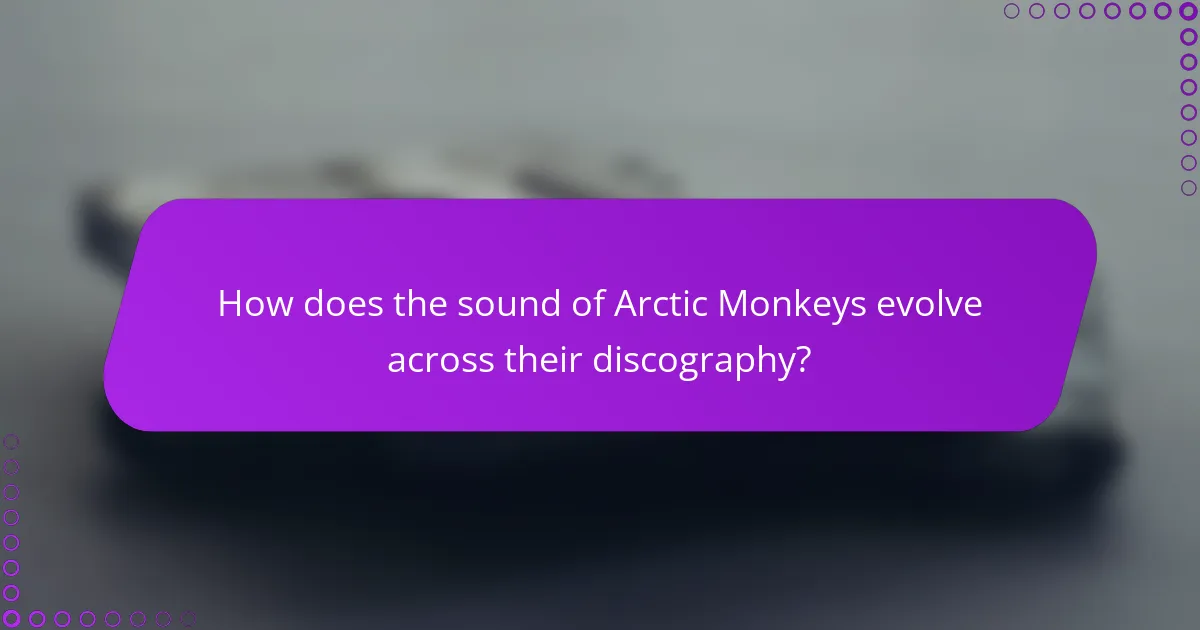
How does the sound of Arctic Monkeys evolve across their discography?
The sound of Arctic Monkeys has evolved from raw garage rock to a more polished, experimental style. Their early albums feature energetic guitar riffs and straightforward lyrics, while later works incorporate diverse influences like hip-hop and orchestral elements. This shift reflects their artistic growth and cultural relevance. For instance, “AM” showcases a blend of rock and R&B, highlighting their unique ability to adapt while maintaining a distinct identity. The evolution of their sound includes a transition from youthful exuberance to introspective themes, marking their journey as a band.
What are the defining musical elements in Arctic Monkeys’ style?
Arctic Monkeys’ style is defined by a blend of catchy melodies, sharp lyrics, and diverse influences. Their sound incorporates elements of garage rock, post-punk revival, and indie rock, creating a unique sonic identity. The lyrics often explore themes of youth, love, and social commentary, showcasing wit and observation. Their cultural significance lies in their ability to capture the zeitgeist of a generation while pushing musical boundaries.
Which albums showcase their genre-blending capabilities?
Arctic Monkeys’ albums “AM,” “Humbug,” and “Tranquility Base Hotel & Casino” showcase their genre-blending capabilities. “AM” integrates rock, hip-hop, and R&B, featuring catchy hooks and rhythmic grooves. “Humbug” introduces darker tones with psychedelic and desert rock influences. “Tranquility Base Hotel & Casino” experiments with lounge pop and space rock, reflecting a unique narrative style. Each album highlights their evolution and versatility in sound.
How do production techniques influence their sound?
Production techniques significantly shape Arctic Monkeys’ sound by blending various musical styles and influences. Their early work features raw guitar-driven tracks, while later albums incorporate more polished production and diverse instrumentation. For example, the use of reverb and layered vocals in “AM” creates a more atmospheric sound, enhancing lyrical themes. Additionally, producer collaborations have introduced unique sonic elements, contributing to the band’s evolution. This dynamic approach allows them to maintain relevance while exploring new musical territories.
What role do live performances play in shaping their musical identity?
Live performances are crucial in shaping Arctic Monkeys’ musical identity. They showcase the band’s energy and connection with fans, enhancing their sound and lyrical themes. The rawness of live shows often contrasts with studio recordings, revealing unique interpretations of their songs. This dynamic experience helps solidify their cultural significance, as audiences engage with the music in a communal setting, fostering a deeper emotional connection. Additionally, the band’s ability to adapt their performances over time reflects their growth and evolution, further defining their artistic persona.
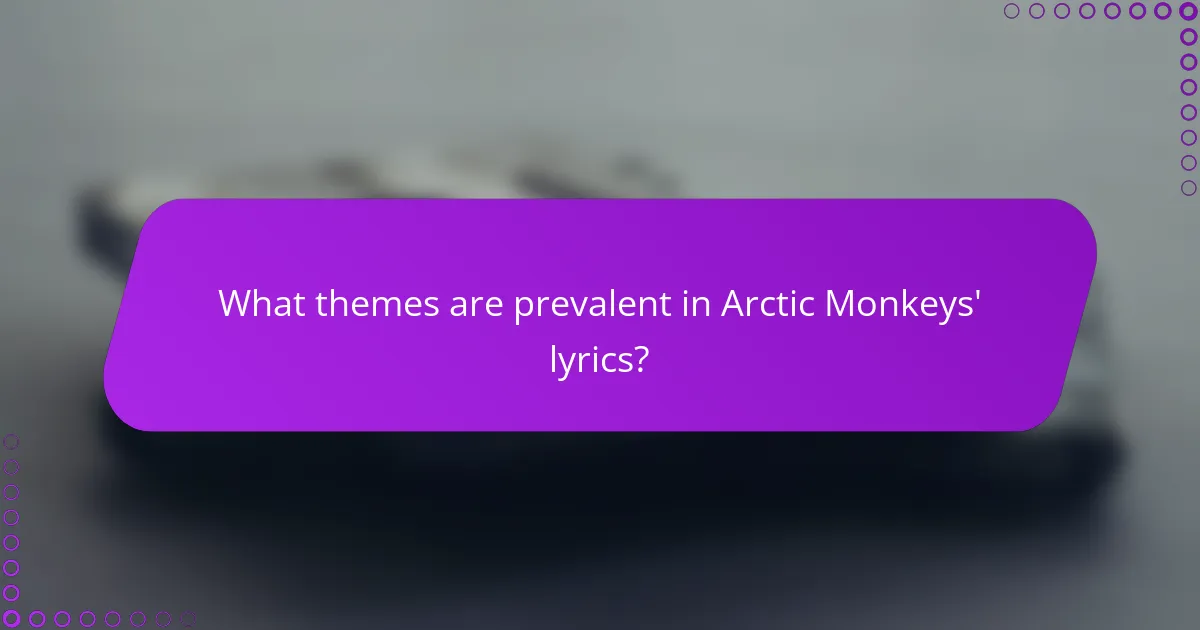
What themes are prevalent in Arctic Monkeys’ lyrics?
Arctic Monkeys’ lyrics often explore themes of love, social commentary, and nightlife experiences. Their songs reflect contemporary culture, relationships, and personal introspection. The unique storytelling style captures urban life, resonating with listeners through relatable narratives. Additionally, rare motifs such as nostalgia and existential angst appear throughout their discography, enhancing their cultural significance.
How do personal experiences inform their songwriting?
Personal experiences significantly shape Arctic Monkeys’ songwriting. The band’s lyrics often draw from real-life events, relationships, and cultural observations. For instance, Alex Turner’s storytelling reflects personal narratives, enhancing emotional depth. This connection resonates with listeners, making their music relatable and culturally relevant. The unique attribute of their work lies in the blend of everyday experiences with sharp wit, creating a distinctive voice in modern rock.
Which social and cultural issues are addressed in their songs?
Arctic Monkeys address various social and cultural issues in their songs, including class struggles, relationships, and urban life. Their lyrics often reflect the complexities of modern existence, exploring themes such as disillusionment and nostalgia. For example, songs like “A Certain Romance” critique social dynamics among youth, while “I Bet You Look Good on the Dancefloor” captures fleeting moments of attraction. The band’s storytelling resonates with listeners, making their music culturally significant. Their unique ability to blend observational commentary with catchy melodies sets them apart in contemporary music.
What storytelling techniques are employed in their lyrics?
Arctic Monkeys employ vivid imagery, narrative storytelling, and relatable characters in their lyrics. These techniques create a strong emotional connection and enhance the storytelling experience. For example, songs like “505” use specific locations to evoke feelings of nostalgia and longing. The band often incorporates colloquial language, making their lyrics accessible and grounded in everyday experiences. Their unique attribute lies in blending personal anecdotes with broader cultural references, allowing listeners to find resonance in their narratives. This combination of storytelling techniques contributes significantly to their cultural significance in modern music.
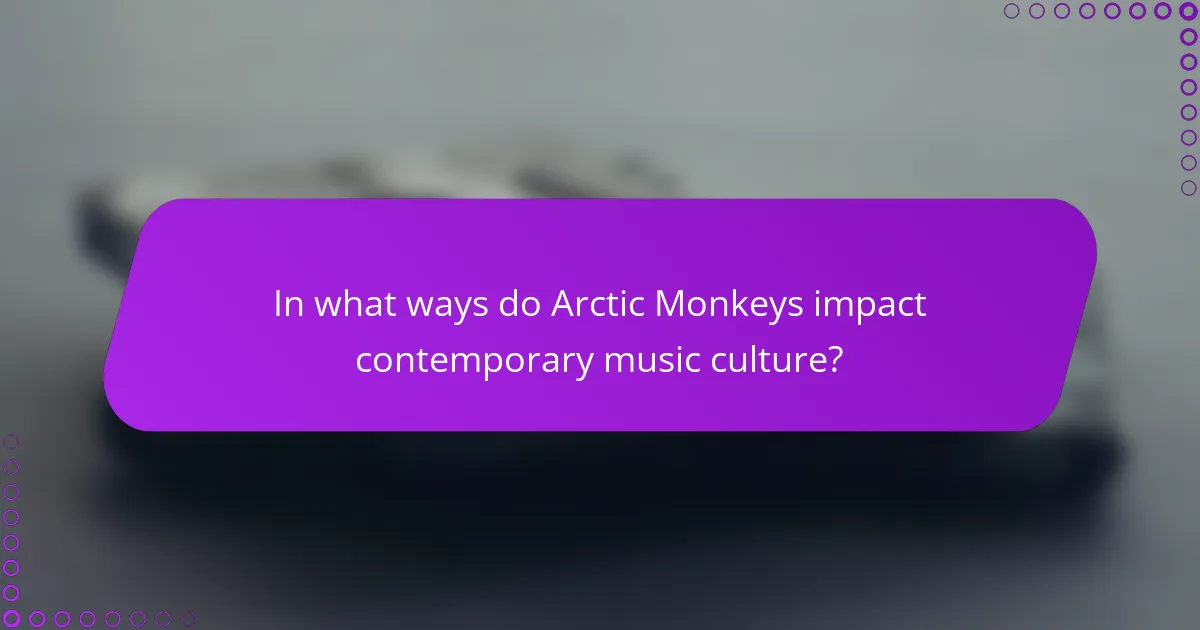
In what ways do Arctic Monkeys impact contemporary music culture?
Arctic Monkeys significantly influence contemporary music culture through their innovative sound and relatable lyrics. Their blend of rock, punk, and indie elements has reshaped modern rock music. The band’s unique storytelling in lyrics resonates with a diverse audience, addressing themes of youth, love, and social issues. Their impact is also evident in the resurgence of guitar-driven music, inspiring new artists and bands to embrace similar styles. The Arctic Monkeys’ cultural significance extends beyond music, as they embody a distinct British identity that influences fashion and youth culture.
How have they influenced emerging artists and genres?
Arctic Monkeys have significantly influenced emerging artists and genres through their innovative sound and relatable lyrics. Their blend of indie rock and garage rock has inspired a new wave of musicians seeking authenticity. The band’s storytelling approach in lyrics resonates with younger generations, encouraging a focus on personal experiences in songwriting. As a result, many contemporary artists have adopted similar lyrical styles and musical elements, reflecting the cultural significance of Arctic Monkeys in shaping modern music trends.
What is their role in the evolution of indie rock?
Arctic Monkeys significantly shaped the evolution of indie rock by blending garage rock revival with clever lyrics. Their debut album, “Whatever People Say I Am, That’s What I’m Not,” showcased their unique sound and storytelling ability. This fusion influenced countless bands and revitalized interest in guitar-driven music. Their cultural significance lies in their relatable themes, reflecting contemporary youth experiences. As a result, they became a defining force in the genre, setting trends that persist today.
How do their lyrics resonate with global audiences?
Arctic Monkeys’ lyrics resonate globally due to their relatable themes and vivid storytelling. Their exploration of love, nightlife, and social commentary connects with diverse audiences. The band’s unique attribute lies in their ability to blend humor with introspection, making their music accessible yet profound. As a result, listeners across cultures find personal meaning in their songs, enhancing the band’s cultural significance.

What unique collaborations have shaped Arctic Monkeys’ sound?
Collaborations with artists like Josh Homme and their work with producer James Ford have uniquely shaped Arctic Monkeys’ sound. These partnerships introduced elements of desert rock and electronic influences, diversifying their musical style. The band’s evolution is marked by experimentation across albums, highlighting their adaptability and cultural relevance. Collaborating with various musicians has allowed them to blend genres and maintain a fresh sound throughout their career.
Which producers and artists have contributed to their albums?
The Arctic Monkeys’ albums feature contributions from various producers and artists, enhancing their distinct sound. Key producers include James Ford, who has worked on multiple albums, and co-writer Alex Turner, whose lyrical contributions shape their identity. Collaborations with artists like Josh Homme on “AM” further diversify their musical landscape.
How do these collaborations reflect their artistic growth?
Collaborations have significantly contributed to Arctic Monkeys’ artistic growth by expanding their musical influences. Each partnership introduces new sounds and styles, showcasing their adaptability. For instance, working with diverse producers has allowed them to experiment with various genres, enhancing their lyrical depth and overall sound. These collaborations reveal their evolution from a garage rock band to a more nuanced, genre-blending group. The incorporation of different artistic perspectives enriches their music, reflecting their maturity and ongoing relevance in contemporary culture.
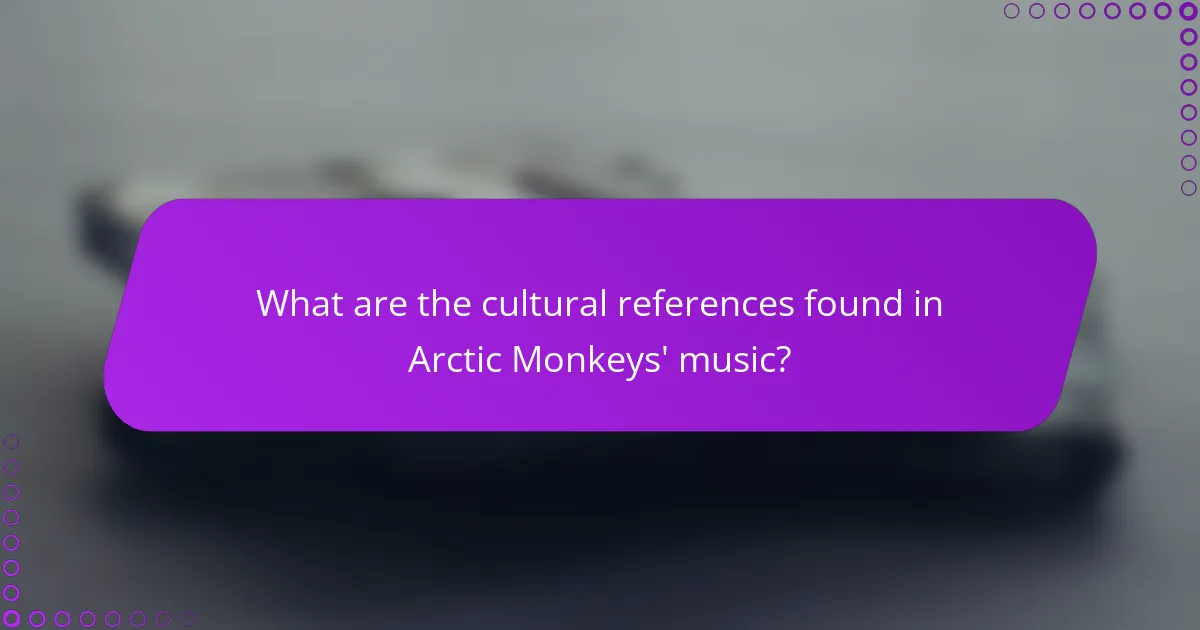
What are the cultural references found in Arctic Monkeys’ music?
Arctic Monkeys’ music features numerous cultural references that reflect British life and society. Their lyrics often draw on elements of urban culture, nostalgia, and social commentary. The band incorporates imagery from films, literature, and everyday experiences, creating relatable narratives. For instance, songs like “I Bet You Look Good on the Dancefloor” capture nightlife dynamics, while “505” evokes a sense of longing and travel. Their unique storytelling style resonates with listeners, making their cultural significance profound.
How do regional influences shape their lyrical content?
Regional influences significantly shape Arctic Monkeys’ lyrical content by reflecting local culture and social dynamics. The band’s lyrics often draw inspiration from their Sheffield roots, incorporating regional dialect, local landmarks, and specific social scenes. This connection to place enhances authenticity and relatability in their storytelling. For instance, references to nightlife and youth experiences in Sheffield resonate with listeners, creating a shared cultural narrative. Additionally, the band’s engagement with broader British cultural themes, such as class and identity, further enriches their lyrical depth. Overall, regional influences provide a unique lens through which the band explores universal themes.
What historical events are woven into their narratives?
The Arctic Monkeys weave historical events into their narratives by reflecting societal changes and cultural shifts. Their lyrics often draw inspiration from British life, addressing themes such as class struggle, urban experiences, and personal relationships. For instance, the song “505” evokes a sense of longing tied to travel and nostalgia, hinting at broader historical movements related to migration and change. The band’s commentary on contemporary issues, such as the impact of technology and social media, also resonates with historical contexts, making their work relevant across generations.

How do Arctic Monkeys engage with their fanbase?
Arctic Monkeys engage with their fanbase through social media interaction, live performances, and exclusive content. They actively use platforms like Twitter and Instagram to share updates and connect with fans, fostering a sense of community. Their concerts often feature unique setlists and fan participation, enhancing the live experience. Additionally, they release behind-the-scenes content, deepening fans’ connection to their music and creative process. These strategies reflect their commitment to maintaining a vibrant and interactive relationship with their audience.
What role does social media play in their fan interactions?
Social media significantly enhances Arctic Monkeys’ fan interactions by fostering direct communication and community engagement. Platforms like Twitter and Instagram allow fans to share experiences and connect with the band’s evolving narrative. This interaction creates a sense of belonging and loyalty among fans. Unique attributes, such as the band’s use of social media for real-time updates and behind-the-scenes content, further strengthen this bond. As a result, Arctic Monkeys maintain a vibrant, interactive fanbase that contributes to their cultural significance.
How do they respond to fan interpretations of their work?
The Arctic Monkeys generally embrace fan interpretations of their work, often engaging positively through social media and interviews. They appreciate the diverse meanings fans derive from their lyrics and sound, viewing it as a testament to their artistic impact. For instance, frontman Alex Turner has expressed admiration for the various ways listeners connect with their songs. This open attitude fosters a collaborative relationship between the band and its audience, enhancing their cultural significance. The band’s willingness to acknowledge these interpretations reflects their unique attribute of valuing fan engagement.

What can listeners learn from Arctic Monkeys’ approach to music?
Listeners can learn about authenticity, narrative storytelling, and cultural commentary from Arctic Monkeys’ music. Their sound blends rock and indie influences, creating a unique auditory experience. The lyrics often reflect everyday life and social observations, resonating with a broad audience. This approach encourages listeners to appreciate the depth of songwriting and the connection between music and culture. Arctic Monkeys’ evolution also demonstrates the importance of innovation while staying true to one’s roots, inspiring artists to balance creativity with authenticity.
What best practices can aspiring musicians adopt from their journey?
Aspiring musicians can adopt several best practices from Arctic Monkeys’ journey. They should focus on developing a unique sound that reflects their identity. Emphasizing authentic lyrics that resonate with listeners is crucial. Building a strong online presence and engaging with fans fosters community. Collaborating with diverse artists can enhance creativity and expand their reach. Consistent practice and experimentation with different styles can lead to growth. Lastly, staying adaptable to industry changes ensures longevity in their careers.
Which common mistakes should artists avoid based on their experiences?
Artists should avoid common mistakes like lack of originality, neglecting audience engagement, and poor time management. Originality is crucial; relying too heavily on trends can lead to a loss of identity. Engaging with the audience fosters loyalty and creates a supportive community. Time management is essential for meeting deadlines and maintaining creativity. Additionally, overthinking can stifle creativity; artists should trust their instincts and embrace experimentation.
